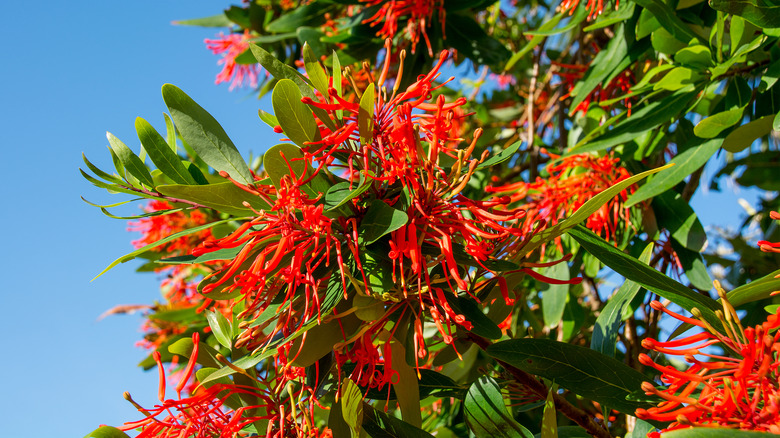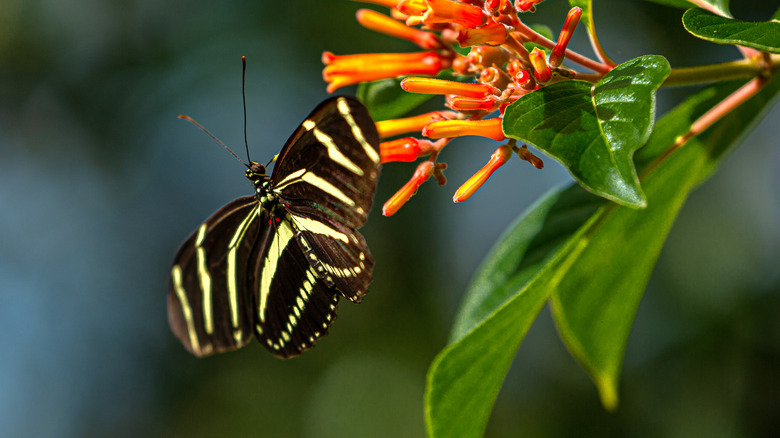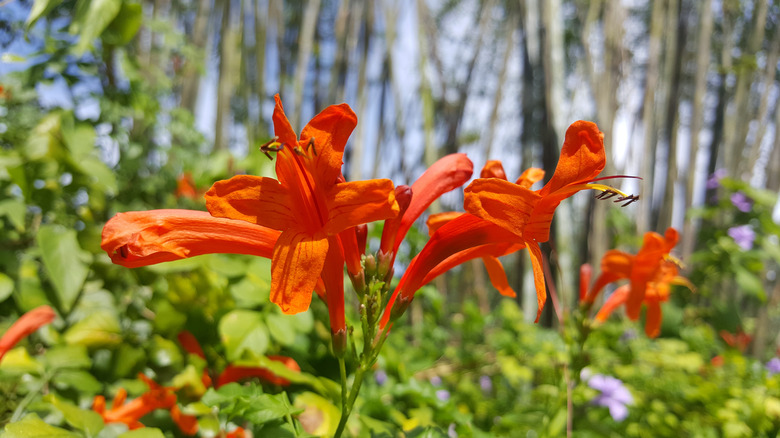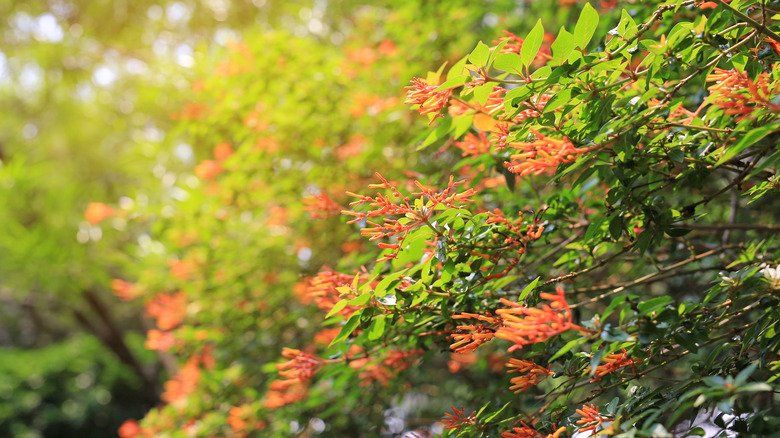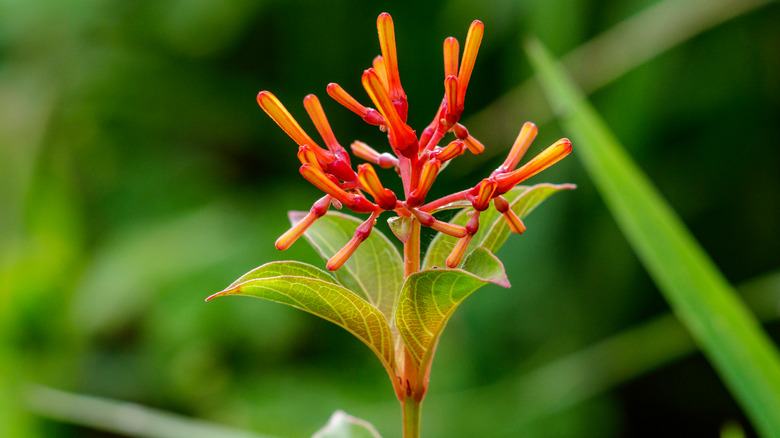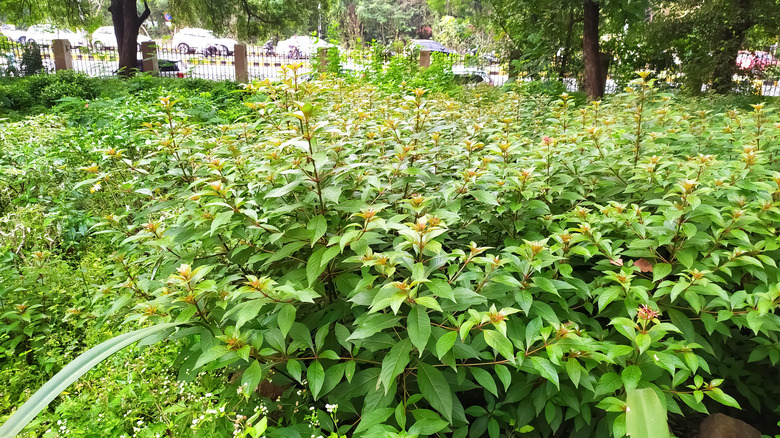Firebush: Everything You Should Know Before Planting
Scientifically known as Hamelia patens, the firebush or scarlet bush is a big, colorful shrub that is indigenous to North, Central, and South America. Its names come from its bold colors and great ability to withstand drought and heat. It comes in different shades of orange and red and thrives in the tropics.
Although it is part of the Rubiaceae family, which is known for its opposite leaves, it has whorled leaves, according to Horticulture Is Awesome. This means its 3 to 7 leaves are equally spaced at a node. Its flowers are shaped like tubes, its leaves are shaped like flattened circles, and it produces many berries in clusters, per Florida Wildflower Foundation. The leaves of a firebush come in various shades of green and are covered with thin "hairs."
Most parts of the firebush can be used for food and medicine, while the whole shrub works great for beautifying a space.
How to use in garden
This bold plant easily catches the eye and will definitely add some beauty to your space. It is commonly used to bring a tropical feel to an area and attracts small fruit-eating birds, bees, and butterflies, which also brings more life. Eat The Weeds recommends this for your lawn because of its striking appearance of flowers and fruits that come out in all seasons. Its berries don't have the best taste when eaten raw, which is why they are usually made into spreads like jelly and syrup.
When carved into the right shape, it looks great on a patio or fence, says The Spruce. If you want it small, it can fit in a hedge or on its own. If you want a big tree instead, you can give it all the room it needs to grow to its full height. You will get a lot of value out of a firebush in your garden because, as a perennial plant, it will live for over two years. That gives you a long time to enjoy this low-maintenance plant that is beautiful all year round.
How to grow firebush
Gardening Know How has a great guide for propagating. Cut about 6 inches of tips from some stems. Cut all the leaves except the top three of four and then cut half of those off in a horizontal direction. Moisten a combination of potting mix and sand/perlite. After covering the ends of the cuttings with a root-stimulating hormone, put them in this combination. You should put the pot or container on a heat mat if you are doing this in a cool climate. Keep the container in an area where it can receive indirect sunlight and keep the soil moist. You can plant firebush outside when it has matured, but you'll have to ease it into an area with six to eight hours of direct sunlight.
You should plant this shrub around late spring or summer and expect it to bloom during the spring to fall seasons, says The Spruce. This fast-grower is easy to cultivate in most soils at most pH levels but prefers a soil mix that is dry and well-draining. Its growth process can be seen through the change in colors, starting with light yellow when budding, orange after it opens, orange-red when it is pollinated, then becoming redder when it flowers (via FANN). It grows anywhere from 3 to 15 feet in height and 2 to 6 feet in width. For a smaller size, cut it down to just the strongest trunk and maintain it that way (via The Spruce).
How to care for firebush
When a firebush is still growing, it needs to be watered regularly, but you can expect it to withstand a lack of water well when it is mature (via The Spruce). It does completely fine in hot and humid weather, and consistent trims during these times will help. However, winters and cold climates are tough for this plant. If it's in a USDA Zone of 8 and above, it won't survive the winter, which means it will only last for a year there, per FANN. Are you in a coastal area and worried about salt? University of Florida Gardening Solutions has good news: firebush can moderately withstand salt spray.
While it is very easy to take care of, it is susceptible to root rot and needs soil that allows water to pass through it quickly instead of pooling at the bottom. It can also be affected by mites, aphids, grasshoppers, and other bugs and insects. The Spruce recommends the use of neem oil (a natural pesticide from the neem tree) first before seeking other treatments.
Firebush Varieties
Dwarf firebush is a shorter variety, according to University of Florida Gardening Solutions. It grows flowers that are light yellow or orange in color and leaves that are smoother than the native species. It is right for those looking for a small, tight firebush and needs more attention, says South Florida Plant Guide. It grows to 3 or 4 feet in both height and width, per Verdego Landscape. This variety is also referred to as compacta and hummingbird bush. Have limited space or want to plant in a container outside? This is the right variety for you.
A newer variety is called "firefly." This one is also more compact with smaller leaves and flowers. It grows to about 5 to 8 feet in height and 5 to 10 feet in width (via Online Plant Guide).
Other top species include:
- Hamelia patens var. glabra: This variety is very similar to the native species and comes from South Africa.
-
Hamelia cuprea: This is native to the Caribbean and has reddish leaves.
Is firebush toxic?
Firebush has a low level of toxicity and good functions, says Science Direct. The leaves and stems of this plant have medicinal properties and can treat insect bites, rashes, and fungal infections. Its small, black berries can also be consumed raw or cooked into something else. Eat The Weeds says a boiled mix of this plant's flowers, stems, and leaves can actually ease period cramps! Indigenous tribes in North and Central America have been known to use it directly to relieve diarrhea and stop wounds from bleeding. They also ingest it in liquid form to treat illnesses and even chew on it to avert heat stroke (via Eat The Weeds). Firebush can even be used for tanning.
Unfortunately, it still has a level of toxicity, which means it can cause issues when touched or consumed. This can lead to irritation, pain, and other internal illnesses, according to the toxic plant list put together by the California Poison Control System.
